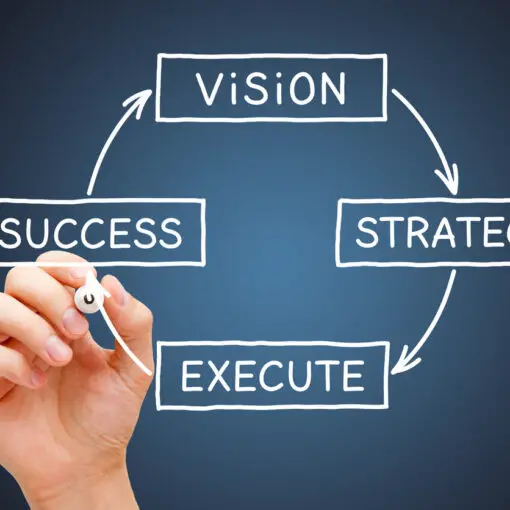Strategic thinking and goal setting are crucial skills in today’s fast-paced business world. The ability to look at the big picture, analyze internal and external factors, and set clear objectives that drive an organization forward can significantly improve performance and overall success. Developing these skills involves understanding the processes of strategic planning and goal setting, as well as consistently implementing these practices in daily operations.

Given the ever-changing landscape of global markets, it is essential for leaders to adapt and be proactive in their planning. A well-designed strategic plan can help businesses remain competitive by identifying new opportunities, anticipating potential challenges, and devising strategies to address them. Goal setting, on the other hand, provides a clear path for teams to follow, ensures that resources are allocated efficiently, and enables progress tracking.
By incorporating strategic thinking and goal setting into daily operations, business leaders and teams can more effectively navigate the complexities of their industries and make informed decisions that align with their overall mission and values. Doing so will ultimately contribute to the long-term growth and success of an organization.
Key Takeaways
- Strategic thinking and goal setting are essential skills for business leaders
- A well-designed strategic plan helps identify opportunities and anticipate challenges
- Incorporating these practices in daily operations leads to better decision-making and long-term growth.
Understanding Strategic Thinking and Goal Setting
What is Strategic Thinking?
Strategic thinking is a process that involves analyzing situations, creating insights, and developing plans to achieve long-term objectives. It is a critical skill for leaders, as it enables them to identify opportunities, anticipate challenges, and craft approaches that can drive their organization’s effectiveness and success. Strategic thinking involves communicating complex ideas, collaborating with internal and external stakeholders, building consensus, and ensuring everyone is aligned and working toward shared goals.
Some qualities of strategic thinkers include:
- Long-term focus
- Creative problem solving
- Adaptability
- Analytical skills
- Effective communication
Defining Strategic Goals
Strategic goals are the specific objectives that an organization, team, or individual sets to guide their actions towards achieving a vision or desired outcome. These goals should be quantifiable or qualitative, meaning they can be measured and tracked using various data points, such as financial figures or productivity rates. Defining strategic goals involves considering the organization’s mission, vision, values, and current position, as well as external factors that may impact future success.
When setting strategic goals, it’s essential to consider the following elements:
- Relevance: Goals must align with the organization’s mission, vision, and values.
- Specificity: Goals should be clear and well-defined, addressing particular areas for improvement or growth.
- Measurable: It should be possible to track progress and success using defined metrics.
- Time-bound: Goals should have a specific time frame for completion, allowing for assessment and adjustments as needed.
- Challenging: Goals should push the organization, team, or individual to overcome obstacles and achieve growth.
By developing strategic thinking skills and setting strategic goals, leaders can enhance their effectiveness, foster a culture of continuous improvement, and navigate their organization towards a successful future.
The Importance of Strategic Thinking in Business

Driving Organization’s Growth
Strategic thinking plays a crucial role in driving an organization’s growth. By applying innovative and forward-focused approaches to business planning, companies can develop strategies with a higher chance of success. It enables them to identify areas for improvement, expand into new markets, and cultivate a strong organizational culture. A well-thought-out strategy can foster long-term growth and help achieve the company’s objectives.
Enabling Effective Communication
An essential aspect of strategic thinking is its ability to improve communication across the organization. By creating a single, forward-focused vision, employees and shareholders can better understand the company’s goals and their role in achieving them. With a clear strategy in place, leaders can articulate their expectations and align the workforce with the organization’s mission. Moreover, effective communication promotes collaboration and teamwork, empowering employees to contribute their ideas and skills towards the company’s success.
Leveraging Opportunities and Threats
Strategic thinking involves analyzing a wide range of information, including market conditions, emerging trends, and internal resource allocation. This analysis allows organizations to identify opportunities and threats and adapt their strategies accordingly. By anticipating potential challenges and leveraging opportunities, businesses can make informed decisions, maximize resources, and build resilience.
To better illustrate the connection between strategic thinking and organizational success, consider the following table:
| Component | Contribution to Organizational Success |
|---|---|
| Innovation | Sparks new ideas, products, and services, driving growth and differentiation |
| Forward-focused planning | Ensures alignment with long-term goals while considering potential changes in the market |
| Clear communication | Enables a shared understanding of the strategy and promotes collaboration and engagement among employees |
| Anticipating opportunities | Enhances the ability to seize favorable situations and achieve a competitive edge |
| Addressing threats | Reduces potential risks and builds resilience to face external challenges |
In conclusion, strategic thinking is a vital skill for businesses, as it drives growth, enhances communication, and empowers organizations to navigate opportunities and threats effectively. By incorporating strategic thinking into their processes, companies can increase their chances of success, secure a competitive edge, and maintain a strong position in the market.
The Process of Setting Strategic Goals
Identifying Vision and Mission
Before diving into the process of setting strategic goals, it is crucial to establish a clear vision and mission for the organization. The vision serves as the ultimate destination or aspiration that an organization seeks to achieve, while the mission outlines the purpose and core values that will guide the organization on its journey. These two elements are the foundation of a solid strategic plan and will shape the direction and priorities moving forward.
Establishing Priorities
After the vision and mission are defined, the next step is to prioritize the issues and areas that need to be addressed. This can be done by conducting a thorough analysis of the organization’s current state, challenges, and available resources. The analysis will help determine which areas require the most immediate attention, and which are secondary or long-term concerns. Once the priorities are set, they will guide the development of the strategic goals and objectives.
Creating Actionable and Measurable Goals
The final step in setting strategic goals is to create actionable and measurable objectives that are directly related to the established priorities. These goals should be specific, attainable, and time-bound, with clear metrics to track progress and success.
A useful method for developing actionable and measurable goals is the SMART criteria:
- Specific: Goals should be clear, concise, and targeted.
- Measurable: Goals should have quantifiable metrics that allow for tracking progress and evaluating success.
- Attainable: Goals should be realistic and achievable, considering the available resources and constraints.
- Relevant: Goals should align with the organization’s vision, mission, and priorities.
- Time-bound: Goals should have a defined timeframe for completion.
An example of a SMART goal for a company looking to expand its market reach could be: “Increase market share in X, Y, and Z markets by 15% within three years by leveraging targeted marketing campaigns and strategic partnerships.” This goal is specific, measurable, attainable, directly aligned with the company’s growth priorities, and time-bound.
It’s important to involve key stakeholders and team members during the process of setting strategic goals, as they can provide valuable insights and contribute to creating a well-rounded strategic plan. Once the goals are set, the organization should work towards achieving them in a systematic manner, consistently reviewing and adjusting the plan as needed to ensure continued success.
Implementing Strategic Thinking in Daily Operations
Application in HR and Marketing
Incorporating strategic thinking into daily operations can significantly impact the success of Human Resources (HR) and Marketing departments. For HR, it ensures that the organization attracts and retains top talent, aligns employee goals with the company’s vision, and fosters a culture of innovation. In marketing, a strategic mindset helps create targeted campaigns, identify market trends, and tailor messaging to the appropriate audience.
HR Strategy:
- Talent Acquisition: Develop a plan to attract high-quality candidates with required skillsets.
- Performance Management: Align employee goals with organizational objectives.
- Organizational Culture: Foster an environment that encourages creative thinking and innovation.
Marketing Strategy:
- Targeted Campaigns: Design marketing initiatives to engage the right audience.
- Market Trends Analysis: Evaluate emerging patterns and anticipate changes in consumer preferences.
- Message Tailoring: Customize communications to align with audience needs and interests.
New Projects and Innovation
Strategic thinking also plays a crucial role in New Projects and Innovation. Following a structured approach for innovation ensures that the organization continues to stay relevant and competitive in the market:
- Idea Generation: Encourage employees to suggest innovative solutions and approaches.
- Project Prioritization: Evaluate and prioritize projects based on their potential impact.
- Resource Allocation: Assign necessary resources, including budgets and personnel, to the selected projects.
- Project Execution: Implement the chosen projects and monitor progress.
Online Strategy Courses and Coaching
To facilitate the development of strategic thinking skills, organizations can invest in Online Strategy Courses and Coaching for their employees. These educational resources offer practical insights and guidance on nurturing a strategic mindset:
- Online courses: Enroll employees in online courses focusing on strategic thinking, planning, and implementation.
- Webinars: Participate in industry-specific webinars to gain insights into strategic trends and best practices.
- Workshops: Organize workshops with expert facilitators to provide hands-on guidance and feedback to employees.
- Coaching: Engage external consultants or in-house coaches to help employees develop and refine their strategic thinking abilities.
By integrating strategic thinking into daily operations, organizations can better navigate challenges and thrive in a competitive marketplace. Implementing these approaches across HR, marketing, new projects, and innovation enables companies to realize their full potential while fostering a culture of strategic excellence.
Evaluating Progress and Success of Strategic Goals
To ensure the success and effectiveness of strategic goals, it is essential to evaluate progress regularly. This evaluation can be achieved through the use of key performance indicators (KPIs) and objectives & key results (OKRs), financial statements analysis, and assessing feedback and employee satisfaction.
Use of KPIs and OKRs
KPIs are quantifiable measurements that show how well a company is achieving its strategic goals. They provide insight into the company’s progress by tracking performance in various areas. OKRs, on the other hand, are a management framework that defines objectives and aligns key results to measure the achievement of those objectives. By implementing KPIs and OKRs, companies can track their progress and make adjustments as needed. These metrics can be organized into a table for easy reference:
| Metric | Purpose |
|---|---|
| KPIs | Measure progress towards strategic goals |
| OKRs | Define objectives and measure success |
Financial Statements
Financial statements provide an excellent resource for evaluating a company’s success in achieving its strategic goals. Balance sheets, income statements, and cash flow statements can all be used to gauge the financial health of a business and its progress towards specific objectives. By analyzing these various components, companies can determine whether their strategic goals are contributing to growth, profitability, and overall financial stability.
Feedback and Employee Satisfaction
Lastly, feedback and employee satisfaction play essential roles in evaluating the success of strategic goals. By soliciting feedback from employees, customers, and stakeholders, organizations can identify areas for improvement and gain insights into the effectiveness of their strategies. Moreover, employee satisfaction can serve as a barometer for the overall health of the organization. A company with satisfied employees is more likely to be successful in achieving its strategic objectives and maintaining a positive work environment. Organizations can regularly conduct surveys and focus group discussions to gather qualitative data on employee sentiment and adjust their strategies accordingly.
By employing these evaluation methods, businesses can effectively monitor their progress towards strategic goals and make necessary adjustments for continued growth and success.





